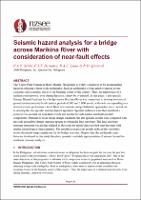| dc.description.abstract | The Valley Fault System in Metro Manila, Philippines is widely considered to be an impending threat in releasing a large-scale earthquake. Such earthquake is forecasted to impose severe casualties and economic losses to the business centre of the country. Thus, the importance of a resilient road network, even during disasters, cannot be overstated.
In this paper, a site-specific seismic hazard analysis for the Marikina River bridge was carried out to develop two sets of ground motion intensity levels (with return periods of 100 and 1,000 years), with each corresponding to a desired seismic performance level. A deterministic approach was utilized to calculate the 5%-damped response spectrum for a hypothetical rupture scenario of the Valley Fault System. Moreover, probabilistic seismic hazard analysis was also done to properly account for uncertainties in magnitude, shaking intensity, temporal occurrence, etc.; the uniform hazard spectrum is then obtained from this calculation. Spectral ordinates from both methods were modified a posteriori to account for near-field effects and resolve to fault-normal and fault-parallel components. Pursuant to local bridge design standards, the results from the two methods were also compared with the code-prescribed design response spectra to obtain the final envelope.
The final envelope response spectrum was further utilized as the target for modifying recorded time-histories with similar seismological characteristics. The modification process greatly reduced the variability across the period range significant for the bridge structure. The earthquake time-histories developed in this study therefore provided a reliable representation of seismic hazard for nonlinear dynamic analysis. | |

